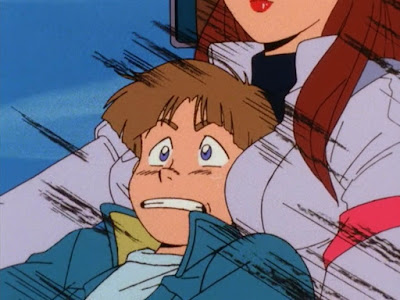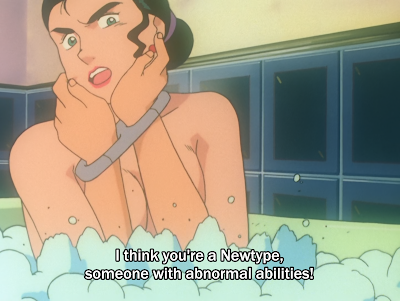In the distant future of the Universal Century, earth comes under attack by the Zanscare Empire, a fanatical theocratic organization originating from the Side 2 space colony Amelia. When BESPA, the military wing of Zanscare, attacks the backwoods Eastern European village of Point Kasarelia, 13-year old Üso Ewin reluctantly joins the local cell of the League Militaire, a guerilla resistance movement dedicated to fighting Zanscare. Üso becomes the pilot of the new Victory Gundam and, along with his friend Shahkti and a group of similarly young and initially naïve League Militaire recruits, learns the true meaning of war, sacrifice, and loyalty.
Release Date:
1993-1994
Episodes:
51
Timeline:
UC 0153
My Grade:
B-
Mobile Suit Victory Gundam is an unusual entry in the Universal Century timeline of the Gundam franchise in that it takes place much farther into the future than any of the other UC releases. By this point in the story, characters like Amuro and Char, and the famed original Gundam itself, have fallen into legend and are, for the most part, not referenced. In other words, though Victory does take place in the UC timeline, it is an outlier that doesn't require much prior viewing, if any. This was by design, as the producers intended this fourth main Gundam series for a younger audience who was likely a lot less familiar with what had become a convoluted backstory.

Likewise, an intentionally younger protagonist was chosen to appeal to the more youthful target demographic. At only 13, you might think that Üso would be one of the less mature and potentially annoying Gundam heroes, but I found him to be quite the opposite. Üso is kind, considerate, and possesses a strong sense of justice. There's very little, if any, trace of the brash hotheadedness and occasional brattiness that some of his predecessors exhibited. He is still written as appropriately immature, though it's usually in a playful and entertaining manner, like how he flushes around older women.
One trait that Üso does possess is an empathetic heart. He is particularly affected by the deaths of his comrades (of which there are many) and even those of the enemies. I felt that this aspect of Üso's personality was one of the stronger elements of the series, as it conveys the traumatic effects of war on a young soldier more realistically than some prior series. Üso truly doesn't wish to kill, at one point exclaiming to an enemy pilot, "The only reason I'm fighting you is because you keep attacking us!" Still, this being a Gundam show, Üso does rack up quite the kill count by the end...
Shahkti, Üso's childhood friend, is the secondary protagonist and plays the archetypal Gundam series role of "special girl." She's a sensitive and caring young woman who is the definitive heart and occasional mother of the whole group. Over the course of the story, Shahkti grows into a formidable character who plays a pivotal role in the outcome of the conflict.
On the League Militaire side, we have an additional host of characters, including Marbet, who becomes a sort of mentor to Üso after an injury forces her to turn over piloting duties of the new Victory Gundam. There are also the old men who serve as the League's engineers and local cell leaders, and lastly there's Shrike Team, an elite all-female mobile suit squad. They're very cool and a lot of fun, but, without getting too into spoilers, let's just say that the members of Shrike Team aren't the most hardy bunch...

The antagonists are a mixed bunch and, for better or worse, are generally portrayed as being a little more human than some prior villains. Each has their own motivations ranging from relatively thin to well-fleshed out. There isn't really a central antagonist; instead, several characters rotate in and out of this role at various points, particularly much later in the story when we get the return of an early villain in a more sadistic and psychotic form. One could argue that Katejina Loos, Üso's former neighbor and one-time friend turned Zanscare loyalist, is the "main villain," but while she certainly does challenge Üso on a number of occasions, both physically and emotionally, she doesn't actually drive the plot and feels more like a personal test that Üso must overcome.
The mecha design in Victory is interesting. The Victory Gundam itself possesses a "back to basics" look after the more sci-fi forms of the Zeta and ZZ. Though clearly more advanced than the original RX-78-2, the Victory is still very recognizable as a Gundam, something I felt was lost with the Zeta in particular. Over the course of the series, it gets all kinds of armor and weapon upgrades, as well as a V2 model, but the Victory still retains its classic "Gundam" look, which I appreciated a lot. That said, I'm generally not a fan of transforming mobile suits and there's a LOT of that here.
The BESPA mobile suits emphasize old-fashioned design as well. There are no Zaku's here, but their Zolo equivalents, with cylindrical "eyes" and gas-mask-like visages, appear heavily inspired by World War I aesthetics, similar to those in the feature film Mobile Suit Gundam F91. They're very "low-tech," using helicopter blades to maneuver in earth's gravity, where much of the early story takes place. As the series progresses, we see more and more advanced Zanscare mobile suits as the bulk of their forces are revealed. Some are completely wacky, such as the dragon-like Doggorla and the Motorad Fleet's army of mobile suits riding inside giant tires (if there was ever a "jumped-the-shark" moment in Gundam, these suits have to be it).
All of this is particularly worth mentioning because of Victory's place in the UC timeline - despite being the furthest into the future, the technology generally looks and feels like it should appear somewhere between the first and second series. Though it's not stated definitively in the anime, I like to imagine that this could be because a certain amount of technological knowledge might have been lost since the older series took place.
Weighing all factors, I feel that Mobile Suit Victory Gundam ultimately works well as a (mostly) stand-alone entry in the UC Gundam timeline, which has a lot to like and can be enjoyed with little background knowledge. Dedicated Gundam fans will certainly get something out of Victory, but more casual viewers should feel safe skipping it.























Comments
Post a Comment